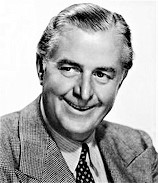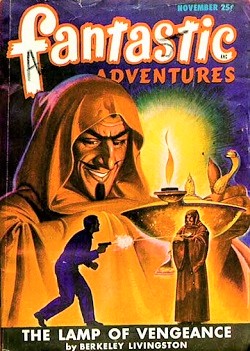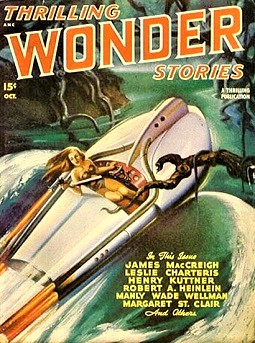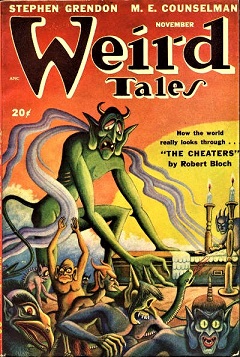
 Escape (1947-54) aired Robert Louis Stevenson’s “The Young Man With the Cream Tarts” on November 12, 1947 as its 14th episode out of over 190. Scottish born Robert Louis (Balfour) Stevenson (1850-1894) is probably best known for his classic adventure novels Treasure Island (1883), Strange Case of Dr. Jekyll and Mr. Hyde, and Kidnapped (both from 1886). Plagued with ill health throughout his life, he died early at the age of forty-four on the island of Upolu, one of the Samoan islands, in the small village named Vailima. He was buried on the slopes of Mt. Vaea, a short distance from the village. Coincidence, perhaps, is that the only Samoan brewery has named its beer Vailima.
Escape (1947-54) aired Robert Louis Stevenson’s “The Young Man With the Cream Tarts” on November 12, 1947 as its 14th episode out of over 190. Scottish born Robert Louis (Balfour) Stevenson (1850-1894) is probably best known for his classic adventure novels Treasure Island (1883), Strange Case of Dr. Jekyll and Mr. Hyde, and Kidnapped (both from 1886). Plagued with ill health throughout his life, he died early at the age of forty-four on the island of Upolu, one of the Samoan islands, in the small village named Vailima. He was buried on the slopes of Mt. Vaea, a short distance from the village. Coincidence, perhaps, is that the only Samoan brewery has named its beer Vailima.
In 1888 Stevenson embarked on a voyage from San Francisco to many ports of call in the Pacific, including Hawaii, Tahiti, New Zealand, and the Samoan Islands. Settling on the aforementioned Samoan island of Upolu, in 1890 he purchased four-hundred acres of land, was well-loved by the native inhabitants, and was known as (and took to calling himself) “Tusitala,” the Samoan name for “Teller of Tales.”

 “The Young Man With the Cream Tarts” is the first of a series of three short stories known collectively as “The Suicide Club.” The stories were first published in the London Magazine from June-October 1878, and then collected in 1882 (with four other stories) under the title New Arabian Nights. The Suicide Club trilogy has this story and the third set in Victorian era London with the second taking place in Paris. All three feature Bohemian Prince Florizel and his aide de camp Colonel Geraldine. In “The Young Man With the Cream Tarts” the pair are out one evening for adventure when circumstances lead them to a secret society of men seeking to commit suicide. What they learn is more than they bargained for and Florizel vows to bring to justice the President of the secret club. It should be noted that this radio adaptation differs from the original story, and concerns the ultimate fate of the suicide club’s President (whose fate is not determined until the final story of the trilogy, but is apparently included here for purposes of closure).
“The Young Man With the Cream Tarts” is the first of a series of three short stories known collectively as “The Suicide Club.” The stories were first published in the London Magazine from June-October 1878, and then collected in 1882 (with four other stories) under the title New Arabian Nights. The Suicide Club trilogy has this story and the third set in Victorian era London with the second taking place in Paris. All three feature Bohemian Prince Florizel and his aide de camp Colonel Geraldine. In “The Young Man With the Cream Tarts” the pair are out one evening for adventure when circumstances lead them to a secret society of men seeking to commit suicide. What they learn is more than they bargained for and Florizel vows to bring to justice the President of the secret club. It should be noted that this radio adaptation differs from the original story, and concerns the ultimate fate of the suicide club’s President (whose fate is not determined until the final story of the trilogy, but is apparently included here for purposes of closure).

 “The Young Man With the Cream Tarts” has been adapted in various media–film, radio, tv, and on the stage–no fewer than two dozen times, dating from 1909 through 2011 at last count. Perhaps most well known is MGM’s 1936 film adaptation titled Trouble For Two. Robert Montgomery (1904-1981, photo upper left) starred as Florizel, Frank Morgan (1890-1949, best known as the wizard in 1939’s classic film The Wizard of Oz, photo above right) as Colonel Geraldine, Reginald Owen (1887-1972, photo at right) as President of the Club, while Hollywood beauty Rosalind Russell (1907-1976, photo at left) was added as a love interest. Of interest to Sherlock Holmes fans is that in 2011 playwright Jeffrey Hatcher commingled parts of all three suicide club stories, but instead of Florizel and Geraldine in the lead roles, he switched them to Sherlock Holmes and Dr. Watson in his Sherlock Holmes and the Adventure of the Suicide Club.
“The Young Man With the Cream Tarts” has been adapted in various media–film, radio, tv, and on the stage–no fewer than two dozen times, dating from 1909 through 2011 at last count. Perhaps most well known is MGM’s 1936 film adaptation titled Trouble For Two. Robert Montgomery (1904-1981, photo upper left) starred as Florizel, Frank Morgan (1890-1949, best known as the wizard in 1939’s classic film The Wizard of Oz, photo above right) as Colonel Geraldine, Reginald Owen (1887-1972, photo at right) as President of the Club, while Hollywood beauty Rosalind Russell (1907-1976, photo at left) was added as a love interest. Of interest to Sherlock Holmes fans is that in 2011 playwright Jeffrey Hatcher commingled parts of all three suicide club stories, but instead of Florizel and Geraldine in the lead roles, he switched them to Sherlock Holmes and Dr. Watson in his Sherlock Holmes and the Adventure of the Suicide Club.
Play Time: 29:31
{After listening to the harrowing episode of “The Young Man With the Cream Tarts” the neighborhood gang shook the shivers from themselves and headed for the corner newsstand the next morning with a spring in their step, despite the November chill. With many genre pulps to choose from, they decided on the issues pictured below. fantastic Adventures ran from 1939-53. In 1947 it published only eight issues, but from September 1947 (two months prior to the issue below) it became a monthly and would remain so until its demise in 1953. Thrilling Wonder Stories published from 1936-55, and while it flirted at various points with monthly or quarterly schedules, it was primarily a bi-monthly publication for the bulk of its existence, as it was in 1947. The cover below is notable for the stellar names on its cover, though some may not recognize the name of James MacCreigh as one of Frederik Pohl’s pseudonyms. Weird Tales (1923-54, the years of its first, classic incarnation), after publishing but nine issues in 1923 and six in 1924, settled in to a regular monthly schedule that lasted from 1925–with minor exceptions–through 1939. In 1940 it became a bi-monthly, a schedule it would maintain until its demise in 1954.}
[Left: fantastic Adventures, Nov. 1947 – Center: Thrilling Wonder, Oct. 1947 – Right: Weird Tales, Nov. 1947]



To view the entire list of weekly Old Time Radio episodes at Tangent Online, click here.